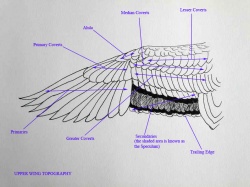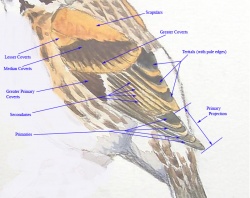| This article is incomplete. This article is missing one or more sections. You can help the BirdForum Opus by expanding it. |
General Anatomy
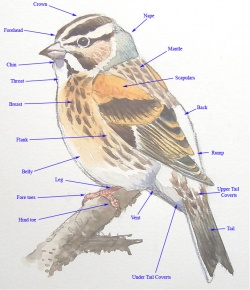
Hopefully the contents of this page will help you learn the body parts and feather tracts of the bird population. It will enable you to write a good description assuming you see a rarity and have to submit a description, as well as understanding someone else's written description.
Tim's picture (right) shows a generalized passerine (perching bird), various parts of the body have been named as well as some of the feather tract names.
A couple of names that are used in some publications but are not shown on the drawing are retrices and remiges which refer to tail feathers and wing feathers respectively.
Coverts refer to feathers that cover other groups of feathers, wing coverts covering wing feathers and tail coverts the tail feathers.
Scapulars are the feathers of the shoulder and can be quite large in some birds.
Heads
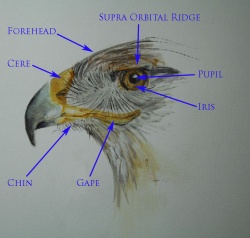
The picture (left) illustrates a ferruginous hawk and shows several features common to most raptors. The cere is the bare area surrounding the nostrils and can be different colours according to species, age and sex of the bird. The gape is the edge of the mouth and is most obvious in very young birds. The iris can also vary in colour according species, age and sex. The forehead can vary in angle of slope, whilst the supra-orbital ridge is what gives some birds the threatening appearance.
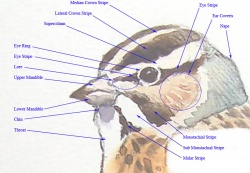
In this generalized passerine head (right) you can see several features that may not all be distinguishable on a real bird. The crown stripes (median, lateral, supercilium and eye) and the cheek stripes (moustachial, sub-moustachial and malar) are shown in order to familiarize the reader with their relative positions, lots of birds will show only 1 or 2 of the stripes. The two enclosed areas show the position of feather groups, which may or may not be different to the surrounding feathers, the lore is the area between the eye and beak whilst the ear coverts (also known as auricluars) are the feathers covering the ear opening.
Beaks
Wings
